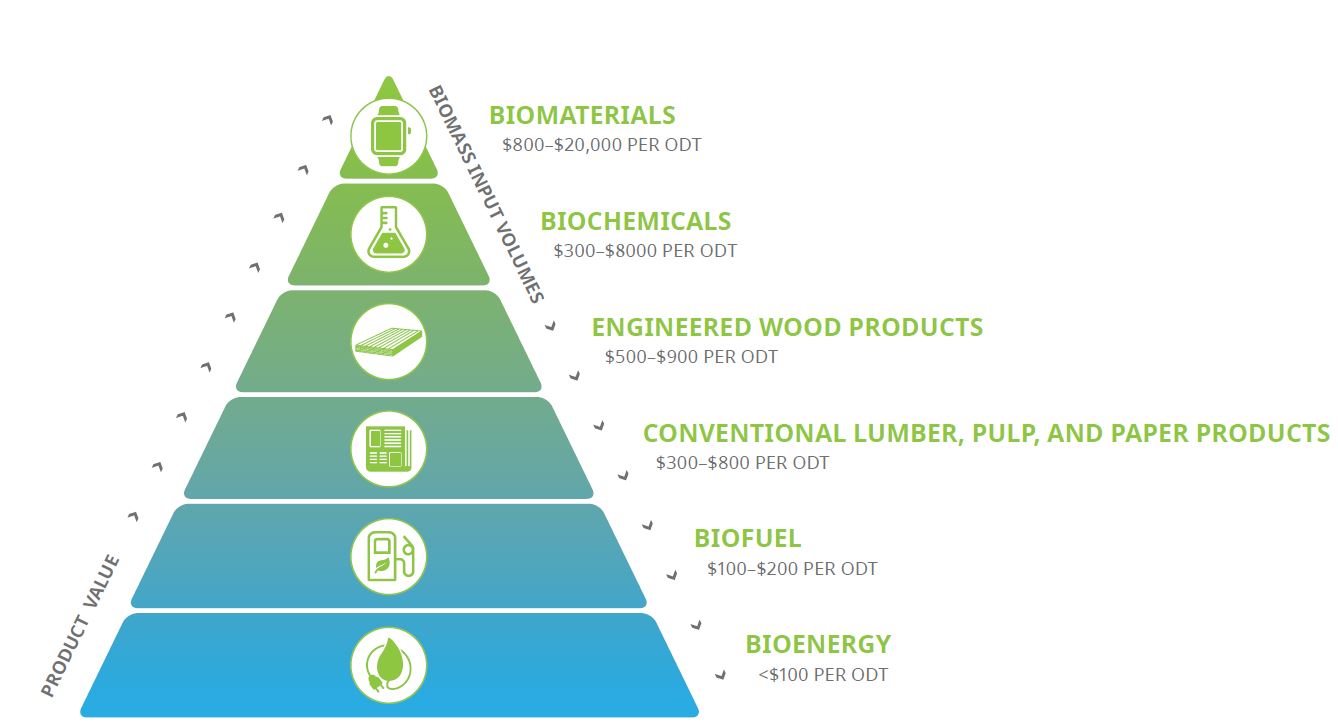Bioproduct development
Through research and development, the forest sector is moving beyond conventional forest products such as lumber, paper and pulp. Many advanced bioproducts are now derived from cellulose and lignin which are chemical components of forest biomass. Explore this page for examples of these emerging bioproducts.
On this page
Advanced bioproducts
Advanced bioproducts include conventional forest products with innovative approaches (e.g. cross laminated timber panels, mass timber products and non-structural EWPs) or conventional non-timber products made with forest biomass. There are five main categories of advanced bioproducts (PDF, 58KB).
Advanced biomaterials have many applications in the built environment. These include products such as plastic and wood composites, adhesives, and cement and concrete used in the construction of buildings. There is growing potential for the use of advanced biomaterials in additive manufacturing such as 3D printing, a technology that has the potential to transform areas of construction and manufacturing.
Examples of advanced bioproducts include:
Biomaterials
Biomaterials are an emerging category of bioproducts produced from cellulose or lignin. These include products such as cellulose nanocrystals, cellulose filaments and reinforced thermoplastic composites. Biomaterials can be sold for between $2,000 and $20,000 per oven dried tonnes (ODT) biomass feedstock. They are used in applications such as food, cosmetics, coatings, packaging, electronics, vehicle parts, and other consumer products. Due to their high values, both biochemicals and biomaterials can be economically feasible at small-scale operations for less than $50 million of capital investment. These can be stand-alone production plants or upgrades to existing pulp and paper mills.
Biochemicals
Biochemicals are an emerging category of bioproducts produced from cellulosic sugars and lignin such as vanillin, xylitol, phenols, or benzene. These chemicals are valued between $1,000 and $8,000 per ODT biomass feedstock and can be used in applications such as food, pharmaceuticals, cosmetics, and adhesives.
Bioenergy
Bioenergy includes products such as renewable natural gas, wood pellets for biomass power generation, and biochar. These products generally sell for less than $100 per ODT of biomass feedstock, putting them at the bottom of this value chain. Biofuels include ethanol and biodiesel, which are not generally produced from wood. These products generally sell for $100 to $200 per ODT of biomass feedstock. Both bioenergy and biofuels require large amounts of feedstock and a large capital investment, between $300 million and $1 billion to be economically feasible.
Bioproducts from lignin
Lignin is derived from a by-product of the pulping process, called black liquor, which is currently burned. However, it can be used in a number of ways to either replace fossil-based raw materials or enhance and apply attributes to products.
-
Bio-Asphalt
Lignin is added to bitumen-asphalt to lower the amount of bitumen used in asphalt paving but also to enhance its durability, extend its life-span and improve resistance against freezing/thawing cycles.
Bioproducts from cellulose
Cellulose rendered from wood can be used to create innovative bioproducts including:
-
Bio-concrete
Cellulosic fibre when added to cement drastically improves resistance to the freezing/thawing cycle and increases the durability in winter conditions overall.
-
Bio-textiles
Using cellulose creates a new generation of bio-sourced textile fibres, yarns and films particularly well suited for outdoor and high-tech clothing. Cellulosic fibre lends unique properties such as odour control, breathability and wettability to the bio-textiles without the use of chemicals.
-
Functional coatings
Cellulosic fibre strands give trees the strength to grow to extended heights. This attribute is used to produce barrier coatings from cellulose for crack detection on glass or damage detection on packaging, while replacing toxic, non-recyclable chemicals and fossil-fuel based materials.
Engineered wood products
This group of bioproducts uses wood, sometimes even waste wood, which is combined to produce wood products that reach sizes that are either expensive or challenging to get in a solid wood form. A number of these products are already used in B.C.’s construction sector in the mass timber industry. Examples are Cross-laminated Timber, Nail-laminated Timber, or GluLam.
Large wooden panels are achieved by nailing or gluing layers of wood together. The stacks of wood are cross-layered, lending load-bearing strength to the panels. The panels are versatile and can either be used structurally, to replace steel or concrete, or used in prefabricated walls, floors or roof sections built off-site, reducing on-site construction time.
Conventional bioproducts
Conventional bioproducts include typical products in the forest sector, such as pulp, paper, or dimensional lumber. These products generally sell for between $300 and $800 per ODT biomass feedstock. They require relatively large capital investments to be economically feasible.

The infographic above shows the value of each bioproducts group by comparing the input of wood fibre to the capital investment needed to be profitable. Low value bioproducts are at the bottom of the pyramid because they require high volumes of wood fibre for lower product value. High value bioproducts are at the top of the pyramid, requiring the least volume of biomass for the highest value output.
